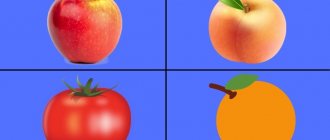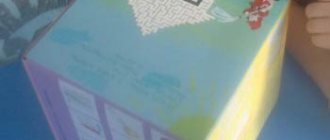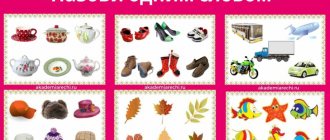Didactic games on ecology for 2nd junior group
Didactic games on ecology for 2nd junior group.
1. “Where is the bunny hiding!”
Target:
describe, name plants based on their characteristic features and in connection with the environment. Write descriptive riddles and guess riddles about plants.
Rules of the game:
A plant can be named only after describing any of its characteristics one by one.
Progress of the game:
The game is played in the park, in the forest, in the square. A driver is selected from a group of children, the rest are divided into two subgroups. The driver hides the bunny under some plant (tree, bush) so that the other children do not see where the toy is hidden. Then the driver describes the plant (if it is difficult, the teacher helps). Whichever group guesses faster what plant the bunny is under, goes to look for it. For example, a toy is hidden under an oak tree. The leader asks the 1st subgroup a riddle: “This is a tree, it has a strong, mighty trunk” (Answers from the children of the 1st subgroup), to the 2nd subgroup: “The leaves of this tree turn brown in the fall” (Answers from the children of the 2nd subgroup) . Etc.
The description riddles continue until one of the subgroups guesses.
2. “Where does it grow?”
Target:
teach children to group vegetables and fruits, develop quick reaction to the teacher’s word, endurance, and discipline.
Rules of the game:
sort out the vegetables and fruits, and put some in the garden, others in the garden (imitation - pictures of a garden and vegetable garden). The team that quickly puts all the items in their places wins.
Progress of the game:
The children are divided into two teams: vegetable growers and gardeners. Vegetables and fruits (dummies can be used) are laid out on the table. At the teacher’s signal, children sort vegetables and fruits into the ones corresponding to the pictures. The team that finishes the job first wins. Children not participating in the teams check the correctness of the selection.
After this, the winning team is announced. The game continues with other teams.
3. "Our friends"
Target:
Expand children's ideas about the lifestyle of animals that live in the house (fish, birds, animals), about caring for them, about their homes, cultivate a caring attitude, interest and love for them.
Material:
lotto cards with images of animals: parrots, aquarium fish, hamsters, turtles, etc. Small cards depicting their homes (cage, terrarium, aquarium, box, etc.), food.
Progress of the game:
Lotto cards are distributed to the participants of the game; the presenter has small cards with the image turned down. The presenter takes any card and shows it to the participants. The participant who needs this card raises his hand and explains why this card is needed specifically for his animal.
To make it more difficult, you can add squats that are not related to these animals.
4. "Flower shop"
Target:
consolidate children's knowledge about plants (meadows, indoors, gardens), consolidate the ability to find the right flower according to the description. Learn to group plants by type.
Material:
you can use cards from the botanical lotto; you can take real indoor plants, but not very large ones.
Progress of the game:
The leader is selected, he is the seller (first the lead teacher, and then the child is selected according to the counting rhyme), the rest of the children are buyers. The buyer must describe the plant in such a way that the seller can immediately guess what plant he is talking about.
5. “The postman brought the parcel”
Target:
To form and expand children’s ideas about vegetables, fruits, mushrooms, etc., teach them to describe and recognize objects by description.
Material:
objects (dummies). Each is individually packaged in a paper bag. You can use riddles.
Progress of the game:
The parcel is brought to the group. The presenter (teacher) distributes parcels to each child. Children look into them and take turns telling what they received in the mail. Children are asked to describe what is in their bag using a description or a riddle.
6. “Edible – not edible”
Target:
to form and consolidate children's knowledge about vegetables and fruits and berries. Develop memory and coordination.
Material:
Ball.
Progress of the game:
The presenter names a vegetable, fruit, berry or any object, throws the ball to one of the participants, if the object is one of the given ones, then he catches it.
You can play with the whole group at once using claps (clap if the item is not one of the given ones).
7. “Wonderful bag”
Target:
To form and consolidate children’s knowledge about various natural objects (animals, vegetables, fruits, etc.). Develop fine motor skills of fingers, tactile sensations, and speech of children.
Material:
A beautifully designed bag, various toys imitating animals, real or fake vegetables and fruits.
Progress of the game:
The presenter holds a bag of objects, invites the children to come up one at a time and identify the object by touch without pulling it out, and name the characteristic features. The rest of the children must guess from its description what kind of object it is, which they have not yet seen. After this, the child pulls out an object from the bag and shows it to all the children.
8. “What comes first, what comes next?”
Target:
To form and consolidate children’s knowledge about the degree of ripeness of vegetables, fruits, the order of growth of various plants, living creatures (fish, birds, amphibians).
Material:
Cards with different order of maturity 3 – 4 – 5 cards for each item (for example: green, small tomato, brown and red), order of growth (seed, sprout, taller sprout, adult plant).
Progress of the game:
Children are given cards with different orders. At the leader’s signal, they must quickly find and line up in order with the required pictures in order.
9.Shop "Seeds"
Target:
Develop and consolidate children's knowledge about seeds of different plants. Learn to group plants by type and place of growth.
Material:
Sign "Seeds". On the counter, in different boxes with models: tree, flower, vegetable, fruit, in transparent bags, there are different seeds with a picture of this plant.
Progress of the game:
The teacher suggests opening a store selling seeds. The store will have four departments. Sellers are selected for each seed department. As the game progresses, child buyers approach the sellers and name their profession: florist, gardener, vegetable grower, forester. Then they ask to sell the seeds of the plant they described and the method of growing them (one per hole, one per furrow, “pinch”, seedlings).
10. “Everyone go home!”
Target:
To form and consolidate children’s knowledge of different plants (trees, bushes), according to the shape of their leaves (fruits, seeds). Reinforce the rules of behavior in the forest and in the park.
Material:
Dried leaves of various trees (seeds, fruits).
Progress of the game:
Before going for a walk with children, the rules of behavior in the forest (park) are reinforced. It is advisable to play the game in the fall (when there are already seeds and fruits), or in the summer (only based on the shape of the leaves). The teacher suggests going on a hike. Children are given leaves (fruits, seeds) of different plants (bushes, trees). Children are divided into groups. The teacher suggests imagining that each group has a tent under a tree or bush. Children walk through the forest (park), at the teacher’s signal “It’s raining. Everyone go home!”, the children run to their “tents”. Children compare their leaves, etc. with those that grow on the tree or bush to which they ran up.
11. “Collect mushrooms in a basket”
Target:
Develop and consolidate children's knowledge about edible and inedible mushrooms, about the place of their growth; about the rules of collecting in the forest.
Material:
Flat baskets, a model representing a forest, a flannelgraph, cards with mushrooms (edible, non-edible).
Progress of the game:
Children are given cards with mushrooms. The children’s task is to name their mushroom, describe it, where it can be found (under a birch tree, in a spruce forest, in a clearing, on a stump, etc.), what it is: edible, put in a “basket”, not edible, leave in the forest (explain Why).
12. “Which branch are the kids from?”
Target:
Develop and consolidate children's knowledge about trees, their seeds and leaves. Reinforce the rules of behavior in the forest and in the park.
Material:
Dried leaves of various trees (seeds, fruits).
Progress of the game:
Before going for a walk with children, the rules of behavior in the forest (park) are reinforced. It is advisable to play the game in the fall (when there are already seeds and fruits), or in the summer (only based on the shape of the leaves). Children walk through the forest (park), at the teacher’s signal “All children on the branches!”, Children run to their trees or bushes. Children compare their leaves, etc. with those that grow on the tree or bush to which they ran up.
13. “When does this happen?”
Target:
Clarify and consolidate children's knowledge about seasonal changes in nature and animal life in different seasons of the year.
Material:
Large lotto cards with a picture of any season. Small cards with models of signs of different seasons.
Progress of the game:
The game is played like a lotto. The presenter has small cards with the image turned down. The presenter shows a card with a model, the players say what it is and when it happens. The child explains why this card is needed specifically for him. The one who closes his card first wins. But the game continues until all participants close their cards.
14. “Guess by the description”
Target:
Develop and consolidate knowledge about the appearance of natural objects (animals, plants, fish, insects, etc.). Develop memory and speech.
Material:
Cards with various types of animals, fish, birds, insects, according to the number of participants or more.
Progress of the game:
Cards are distributed to children. Their task is to describe the object without showing it so that others can guess who is depicted on their card. You can use riddles.
15. “Let’s reap the harvest”
Target:
Develop and consolidate children's knowledge about vegetables, fruits and berries. Their place of growth (garden, vegetable garden, bed, tree, bush, in the ground, on the ground).
Material:
Baskets with models: vegetables, fruits and berries (one basket). Models of vegetables, fruits and berries, or lotto cards with vegetables and fruits.
Progress of the game:
In certain places in the group, pictures of a vegetable garden and a garden are placed, where dummies or cards are located. Children can be divided into two teams: gardeners and gardeners. At the leader’s signal, the teams collect the harvest in their basket with the model. Condition: You can only transfer one item at a time.
16. "Vegetable storage"
Target:
To develop and consolidate children’s knowledge about the external signs and characteristics of vegetables and fruits, their external signs for storage and preparation, and methods for preparing them.
Material:
Planar image of jars for pickling and compotes, barrels for sourdough, storage boxes, freezer. Sets of small cards with vegetables, fruits and berries.
Progress of the game:
Each child has a set of small cards with vegetables, fruits and berries. Divide the children into teams (depending on the number of children). Each team makes its own “preparations” from its own vegetables, fruits and berries.
Or, from the total number of small cards, teams (salt, ferment, fold for storage) choose which preparations require certain vegetables, fruits and berries.
17. "Zoo"
Target:
To form and expand children’s ideas about the nutrition of domestic and wild animals (birds, animals), to cultivate a caring attitude, interest and love for them.
Material:
cards of different animals, birds, insects, food, vegetables and fruits.
Progress of the game:
Children are encouraged to feed the animals at the zoo. The game is played like a lotto. The presenter shows cards with food and insects. The player who needs this card raises his hand and explains why this card is needed specifically for his animal or bird.
Equipment: Place identical sets of vegetables and fruits on two trays. Cover one for the teacher with a napkin. Progress of the game: The teacher briefly shows one of the objects hidden under the napkin, removes it again, then asks the child: “Find the same one on another tray and remember what it’s called.” The task is completed until all the fruits and vegetables under the napkin are named. “Guess what’s in your hand” Didactic task: Recognize the named object using one of the analyzers. Game action: Running to the teacher with an object recognized by touch. Rule: You cannot look at what is in your hand. You need to find out by touch. Progress of the game: The child puts his hands behind his back. Then the teacher moves away and shows a vegetable or fruit. If the child has the same one in his hands behind his back, the child should run up to the teacher. “Tops - roots” Didactic task: To consolidate knowledge about the gifts of the garden and vegetable garden. How to play: Children sit in a circle. The teacher names vegetables, the children make movements with their hands: if a vegetable grows on the ground, in a garden bed, the children raise their hands up. If the vegetable grows underground, the hands are lowered down. “Wonderful bag” Didactic task: Find out an object using one of the analyzers. Game action: Search by touch for a hidden object. Rules: You cannot look into the bag. First you need to determine what is in your hand, and then show it. Equipment: For the first games, we select vegetables and fruits that differ sharply in shape, then more similar ones. A small opaque bag. Progress of the game: The teacher puts vegetables and fruits in a bag and asks to observe what he will do. Then he invites the child: “Find by touch, without looking into the bag, what you want.” Now tell me what you took.” Or you can ask: “find what I say.” Second option. Didactic task: Recognize an object by touch using the listed characteristics. Progress of the game: The teacher lists the signs that can be perceived by touch: shape, its details, surface, plane - and asks: “Find in the bag something that looks like a ball, but with a long tail, hard, not smooth.” According to the description, the child searches for and finds beets. First, vegetables and fruits, which differ sharply in shape, are placed into the bag. When repeating the game, you can select objects that are similar in shape, but differ in other ways. “Guess what you ate” Didactic task: Find out an object using one of the analyzers, stimulate the development of imagination. Game action: Guessing the taste of vegetables and fruits. Rules: You can't look at what you put in your mouth. You have to chew with your eyes closed, and then say what it is. Equipment: Select vegetables and fruits of different tastes. Wash them, peel them, then cut them into small pieces. Place the same items on the table for control and comparison. Progress of the game: Treat the child to one of the pieces, after asking him to close his eyes. “Chew well, now tell me you ate it.” Find the same object on the table.” “Find what I’ll tell you about” Didactic task: Find an object based on the listed characteristics. Progress of the game: The teacher describes in detail one of the objects lying on the table, that is, names the shape of vegetables and fruits, their color, taste. Then the teacher asks one of the children: “Show it on the table, and then name what I told you about.” Second option. Didactic task: Describe and name the characteristics of a plant in response to the teacher’s questions. Progress of the game: The teacher sits facing the children, with his back to the indoor plants standing on the table. The teacher asks one child to choose and show the children a plant, which he will then have to recognize from the children’s description. The teacher asks them questions about the presence of the stem, shape and color. For example: “What does it look like, a tree or grass? Is the trunk thick and straight? Are the leaves big, like a cucumber? Dark green, shiny? Having recognized the plant, the teacher names and shows it. “Find what I’ll tell you about 2” Didactic task: Training in quickly finding the named tree. Progress of the game: The game is organized as an outdoor game. The teacher explains that the driver can catch those children who are not standing near the named tree. The teacher first names those trees that have bright distinctive features, then those that are similar in appearance. All children must listen carefully to which tree is named and, in accordance with this, run across at the signal “One, two, three - run!” “Describe, we will guess” Didactic task: Identify and name the characteristic features of an object in response to questions from an adult. Progress of the game: The teacher tells the children: “From the vegetables that are on the table, choose one. I will ask what he is like, and you answer. Just don't say its name. I’ll try to guess from your answers.” Then the teacher begins to ask questions in a certain sequence: “What form? Everywhere, like a ball? Are there any holes? What colour?". Children answer questions in detail. After the children talk about the characteristic features of the object, the teacher guesses riddles. “What’s missing?” Didactic task: Name plants from memory. Progress of the game: The teacher asks the children to take a good look at how the plants stand and close their eyes. At this time, he swaps the plants on one table. And then he asks the children to rearrange the pots the way they were before, comparing their arrangement with the order of the plants on another table. “Let's treat the dolls” Didactic task: Continue to introduce auxiliary means that have a fixed purpose. Equipment: Two dolls, children's furniture and dishes. “Wonderful bag”, items to choose from (toys and natural objects). How to play: Place 3-4 small items in a bag. The teacher comes with a doll and asks the children to help the doll prepare a treat for the animals, they will also come to visit. One child, at the doll’s request, takes a carrot out of the bag for the bunny, another – an apple for the hedgehog, and a third – a nut for the squirrel. Each time there should be 3-4 items in the bag, so that, in addition to the necessary ones, there are additional ones (for example, a small ball, a plastic ring, etc.). Children who have taken out objects hold them in their hands. The teacher brings toys for the animals. Children take turns treating them, choosing who to give a carrot, nut, or apple. The animals are happy and thank the children. “Where did Sasha hide?” Didactic task: Grouping plants according to their structure (trees, shrubs). Progress of the game: The game is played during excursions to the forest or park. The teacher tells the children: “Now let’s play. You will be squirrels and bunnies, and one of you will be a fox. The squirrels are looking for a plant to hide on.” During the game, the teacher helps the children clarify that hares live and hide in the bushes. They choose a fox driver, give him a hat, a fox mask, and all the other children get hats of hares and squirrels. On the signal: “Danger fox!” squirrels run to the tree, hares run to the bushes. “In the winter dining room” Didactic task: To consolidate children’s knowledge about wintering birds and their names. Develop the ability to imitate their habits. Progress of the game: We look at pictures with birds, the teacher offers to name it and show how it screams, how it flies and jumps. “What kind of bird is this” Didactic task: To consolidate children’s knowledge of what sounds birds make, to teach them to easily pronounce the sound “R”. Progress of the game: The teacher, imitating the cry of a bird, asks the children who screams like that. Children, guessing, choose the corresponding picture. “Birds” Didactic task: To train children in the ability to coordinate their words and actions, to activate children’s speech. Progress of the game: The teacher reads a poem and the children show these movements. Two small birds were flying. As they flew, all the people watched. As they sat down, all the people were amazed. "What is it for?" Didactic task: Note their appearance, specify the names of body parts; tell us about where they live. Progress of the game: The teacher has pictures with images of animals, and the children have pictures of the habitats of various animals (burrow, den, river, hollow, nest, etc.). The teacher shows a picture of an animal. The child must determine where it lives, and if it matches his picture, “settle” it by showing the card to the teacher. “Which flower was removed?” Didactic task: Describe an object and recognize it by description. Progress of the game: Plants stand in their usual places. The teacher invites one of the children to choose one of them and describe it so that all the children know and can say what kind of plant it is. Consistency of description is necessary. Four or five plants are placed on a table. Children remember them. The teacher invites the children to close their eyes and removes one of the plants. Children open their eyes and remember which plant was still standing. The game is played 4-5 times. You can increase the number of plants on the table each time. “Guess by description” Didactic task: To develop in children the ability to take into account the named characteristics of an object and to develop observation skills. Progress of the game: There are five indoor plants on the table, which show clear signs of difference. After a verbal description of the plant, the child finds it among the others. “Guess whose tail” Didactic task: To develop the ability to analyze, consolidate the ability to distinguish and name animals. Progress of the game: The teacher gives the children drawn animal faces, and then one by one shows the drawn tails. Children must name “their” animal and choose a suitable tail for it. “Through the stream” Didactic task: To develop in children a sense of balance and attention. Progress of the game: Children are asked to carefully walk along the bridge (geometric fabric figures) to the other side and find themselves on the lawn, where they frolic and pick flowers. At the signal “Home!” returning across the bridge.




